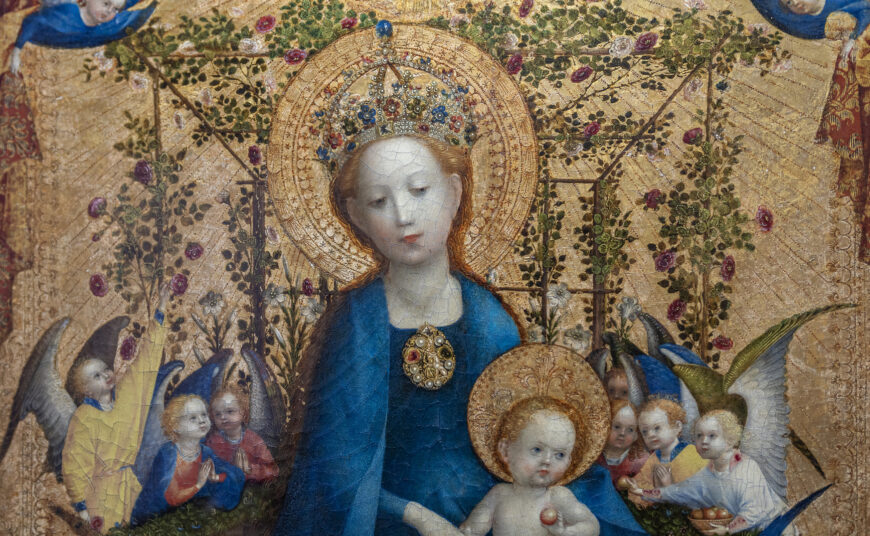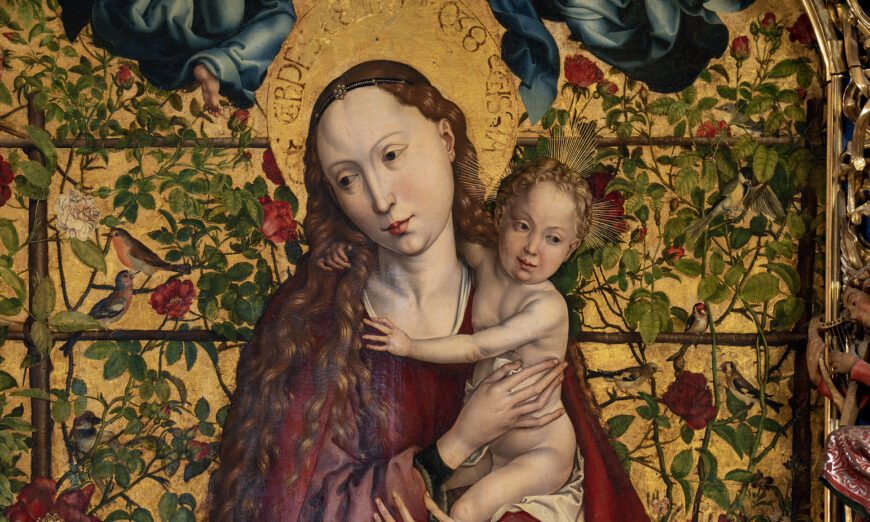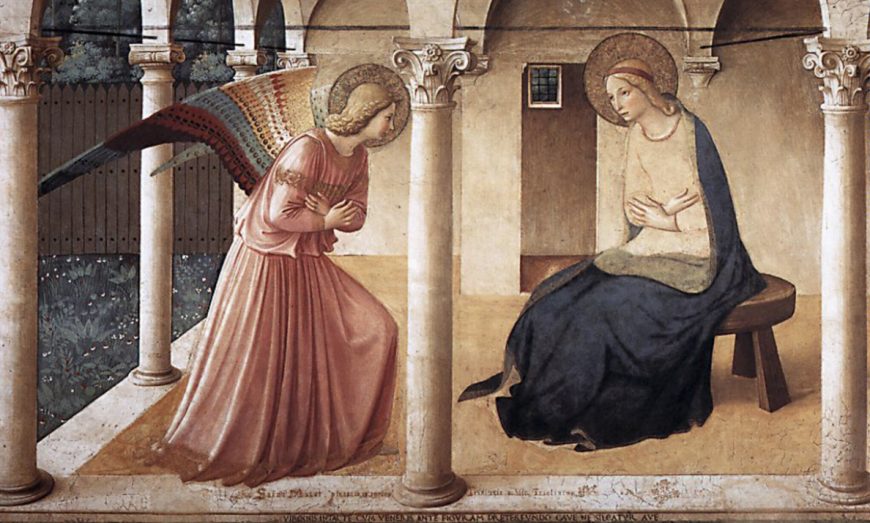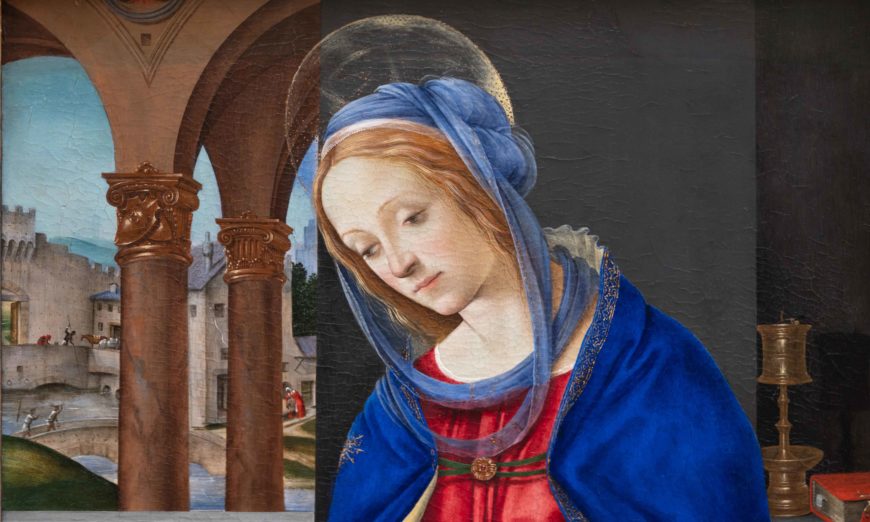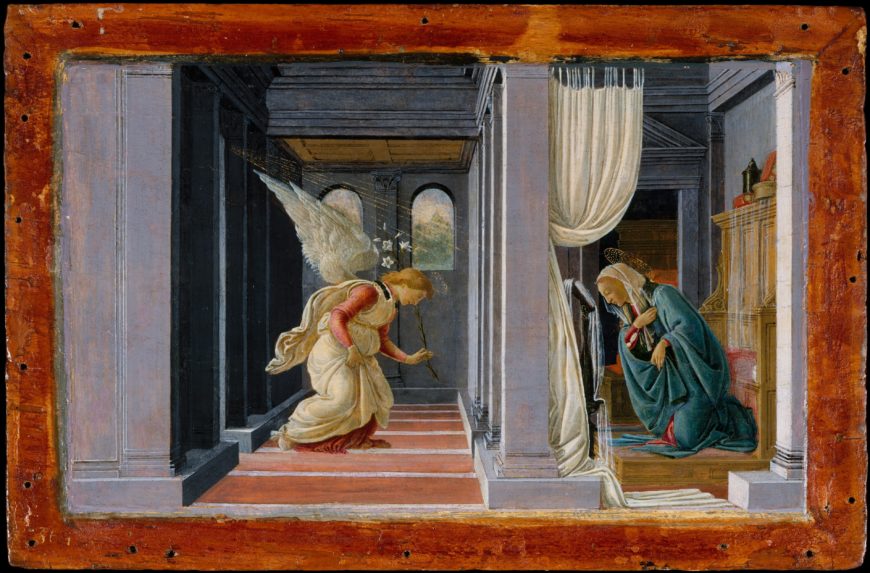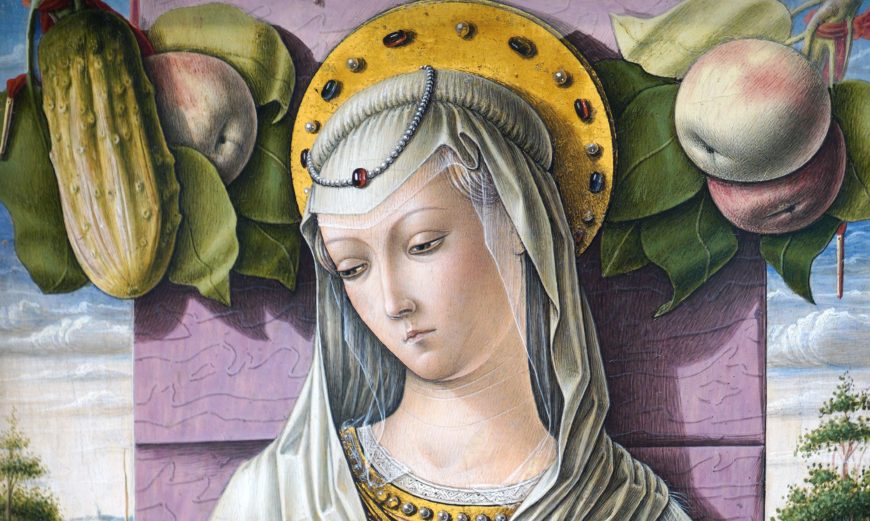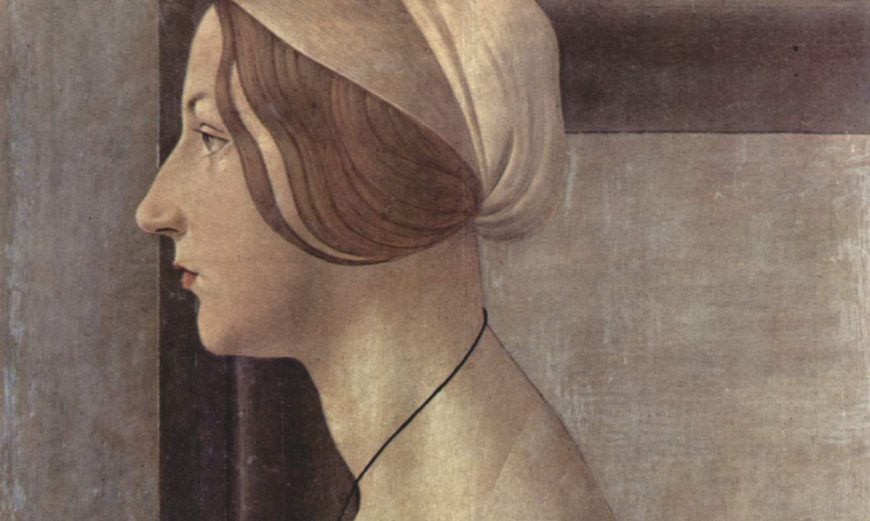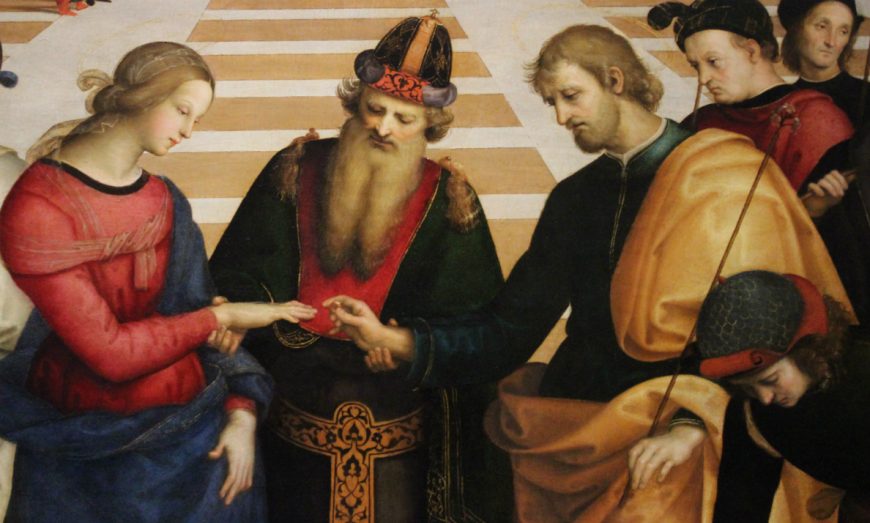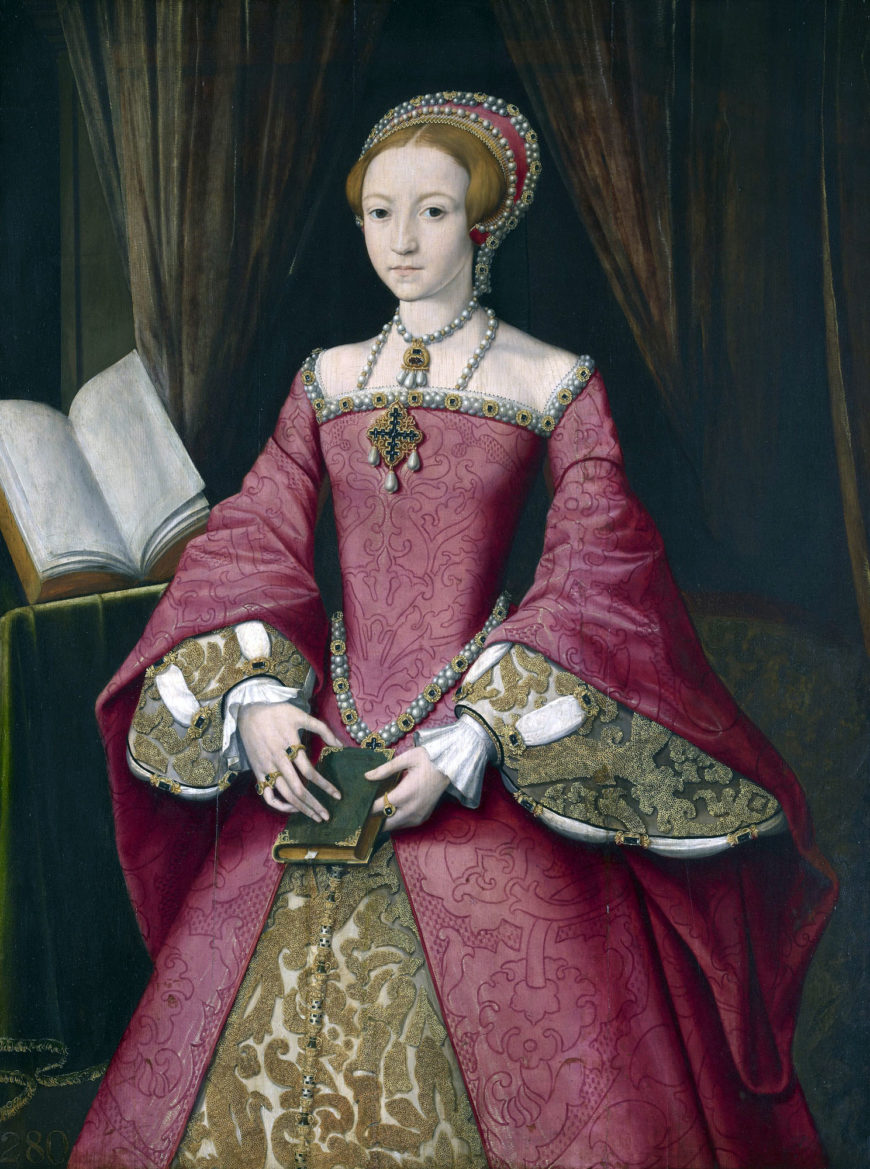
William Scrots, Elizabeth I as a Princess, c.1546, oil on panel, 108.5 x 81.8 cm (Royal Collection Trust)
An Accident of Birth
Elizabeth I was meant to be a boy. In the letters announcing her birth on 7th September 1533, optimistically prepared in advance, we can see where the writer had to squeeze an ‘s’ onto the end of “prince.” [1] As a woman, nobody expected Elizabeth to become queen. Like her older half-sister Mary I, Elizabeth was declared illegitimate and excluded from the succession for a time following Henry VIII’s third marriage and the birth of Edward VI. Yet, when she did take the throne in 1558, following the deaths of her childless siblings, the androgynous spectre of Elizabeth the Prince[ss] loomed large as courtiers and artists attempted to represent and define this unprecedented monarch.
As a female, unmarried, Protestant ruler there was no established iconography on which Elizabeth’s portraits could draw. [2] She rarely commissioned artists herself, so the portraits we have of her were generally commissioned by courtiers with their own agendas. This was part of a strategy by Elizabeth to keep her nobles in line by forcing them to compete for her favor, but it also produced what Susan Frye has referred to as the “competition for representation”: the struggle between the Queen and her court to control her image. [3] The iconic vision that we now have of the “Virgin Queen” was a long time coming, and far from inevitable or obvious when she took the throne in 1558.
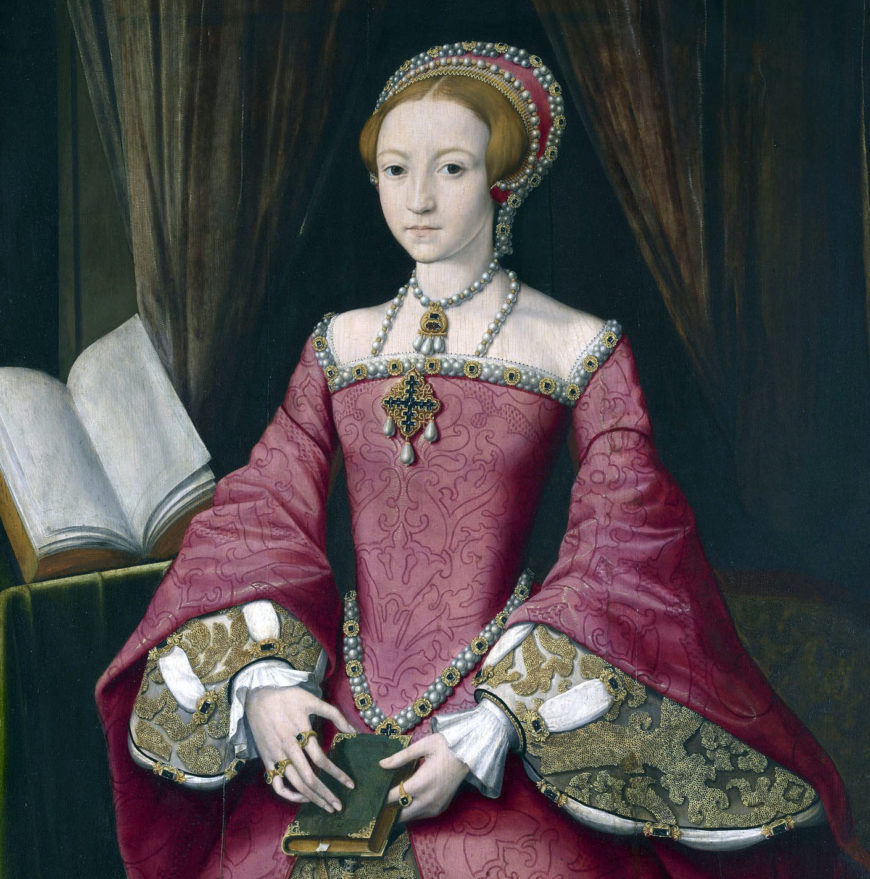
William Scrots, detail of Elizabeth I as a Princess, c.1546, oil on panel, 108.5 x 81.8 cm (Royal Collection Trust)
Elizabeth as a Prince[ss]
The earliest surviving image of Elizabeth I was painted when she was a princess, about a year before her father died. This portrait shows the fair-haired, dark-eyed girl, about thirteen years old, gazing spookily out at the viewer. At this point her expected role was to marry and form alliances for the good of the dynasty. Her crimson dress and exquisite jewelry reveal her royal status. The books in her hands and propped open behind her advertise her learning and piety, while her neat figure and self-possessed stance allude to her potential as an attractive bride.
Elizabeth’s femininity, which made her a suitable pawn in marriage negotiations, posed a problem when she became queen. In Tudor society women were deemed weaker than men: destined not to rule, but to be ruled by their fathers, brothers and husbands. But what if a woman became monarch? Some of these problems had already been addressed in the previous reign: Mary I’s government issued the 1554 Act Concerning Regal Power, which effectively declared that monarchy trumped gender. A woman on the throne was both king and queen, or as Archbishop of York Nicholas Heath put it in 1559, Elizabeth was “our sovaraigne lord and ladie, our kinge and quene, our emperor and empresse.” [4]
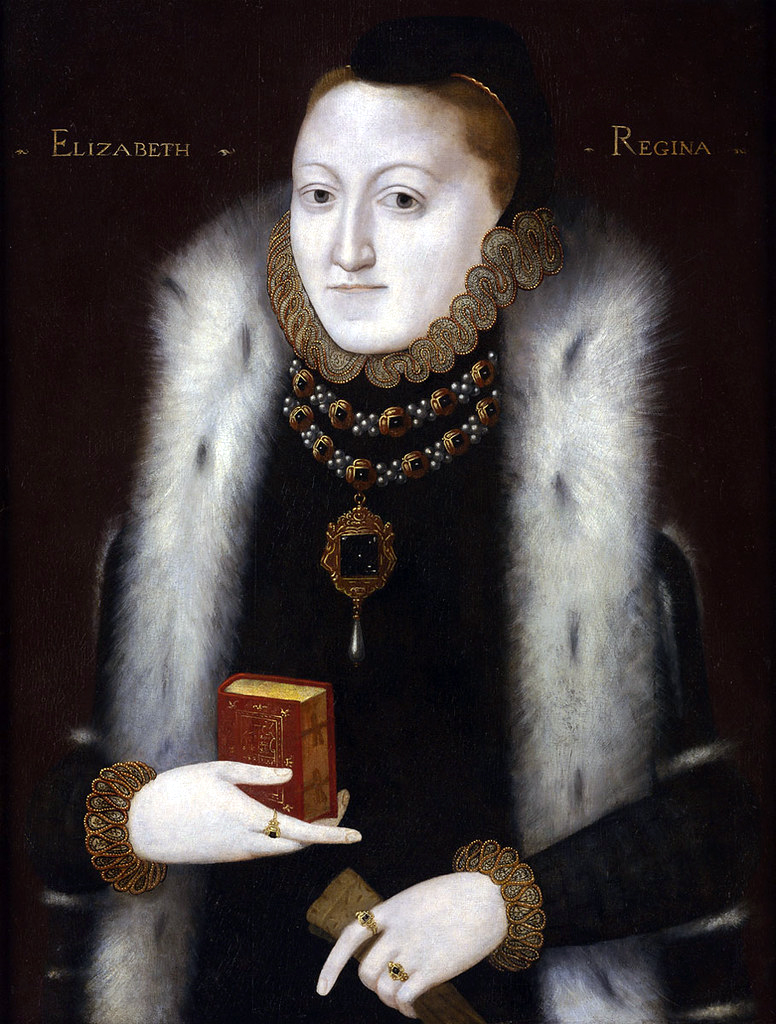
The Clopton Portrait, c.1558, oil on oak panel, 67.5 x 48.9 cm (private collection, previously with Philip Mould)
The earliest surviving portraits of Elizabeth I as queen register this androgyny. Images such as the Clopton Portrait often show Elizabeth with a book to indicate her erudition and dedication to the Protestant faith, recalling the image of her as a princess. [5] Yet in contrast to that earlier image the line of her body is hidden under her black clothing. Shoulders square, hair tucked away, Elizabeth is made to appear almost masculine: a conscious strategy to legitimize her as ruler.
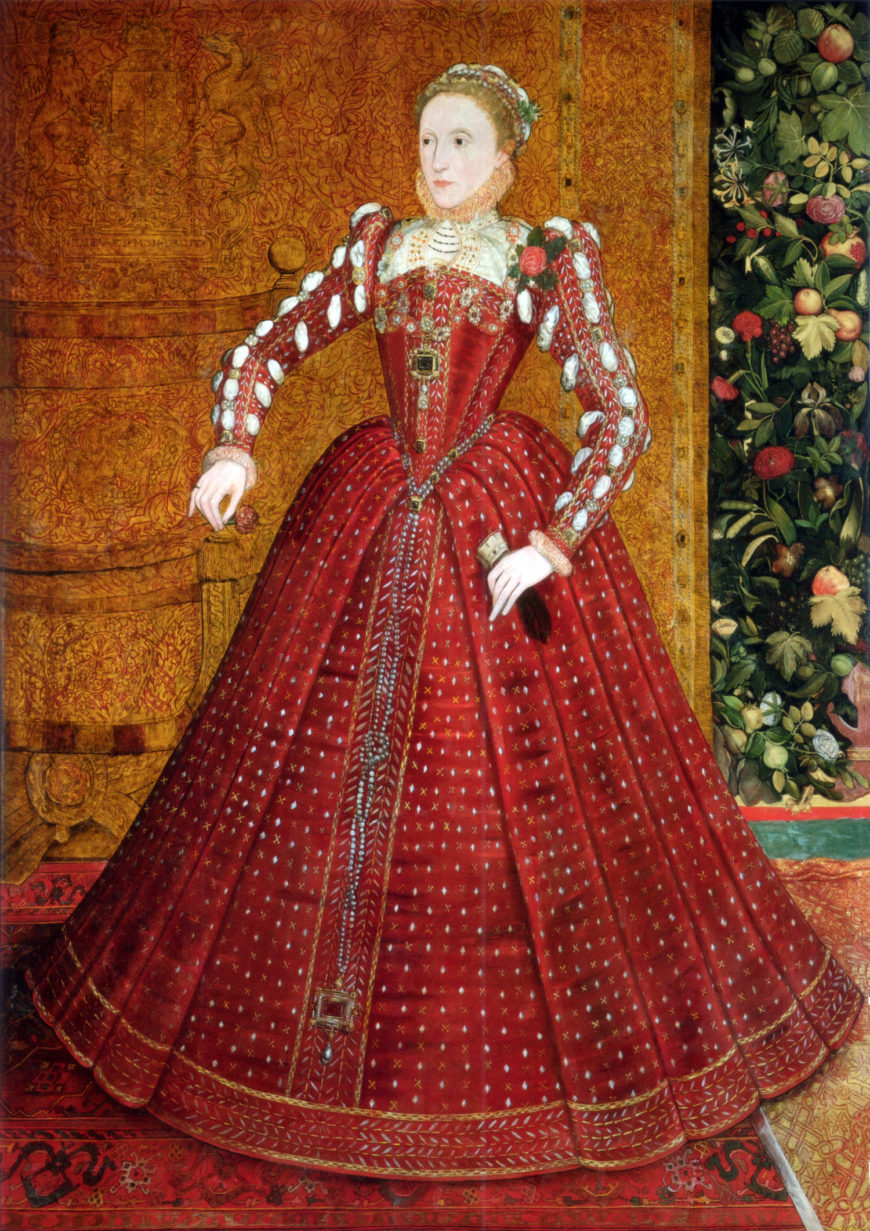
Steven van Herwijk (attributed), The Hampden Portrait, c.1563, oil on panel, 196 x 140 cm (private collection, previously with Philip Mould)
Entering the Marriage Market
In 1562 Elizabeth caught smallpox and nearly died. The threat this posed to the political and religious situation in England terrified her courtiers, and they pressured her to marry and produce an heir. In 1563 a Draft Proclamation—never enacted—expressed the desire for a better image of Elizabeth, probably partly for use in marriage negotiations, as “hitherto none hath sufficiently expressed the natural representation of her majesty’s person, favor, or grace, but that most have so far erred therein as thereof daily are heard complaints amongst her loving subjects.” The Draft Proclamation indicates more generally that poor-quality images were felt to undermine Elizabeth’s authority. It concludes with an ambition “to forbid and prohibit the showing or publication of such [images] as are apparently deformed” until an approved image could be created. [6]
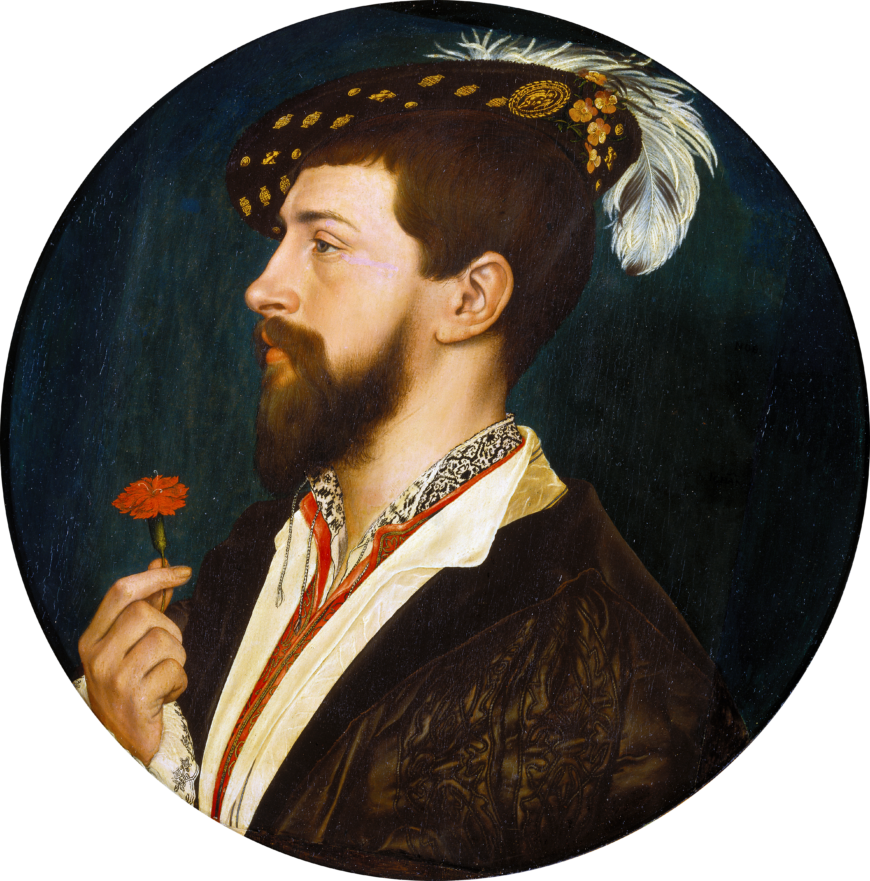
Hans Holbein the Younger, Portrait of Simon George of Cornwall, c. 1535–40, mixed technique on oak, 31 cm in diameter (Städel Museum, Frankfurt am Main, CC BY-SA 4.0)
This approved image may have taken the form of the Hampden Portrait, the first full-length image of Elizabeth. Elizabeth rests her hand on an x-frame chair under a cloth-of-gold canopy of state—emblems of her authority. She is wearing the red-and-white colors of the Tudor dynasty, and holding a carnation, a common symbol of courtship (as we see in a portrait of Simon George of Cornwall). To the right a verdant band of flowers, foliage and fruits—frequently in pairs—evokes fertility: Elizabeth was entering the marriage market. For two decades she toyed with marriage negotiations, but in the late 1570s finally seemed to have met her match in Francis, Duke of Anjou, brother and heir presumptive of the French king. Unfortunately by now Elizabeth was in her mid-forties: her courtiers felt that childbirth was too risky, and if she died childless while married to Anjou, England could become French property. They advised against the marriage, and negotiations were finally broken off in 1581.
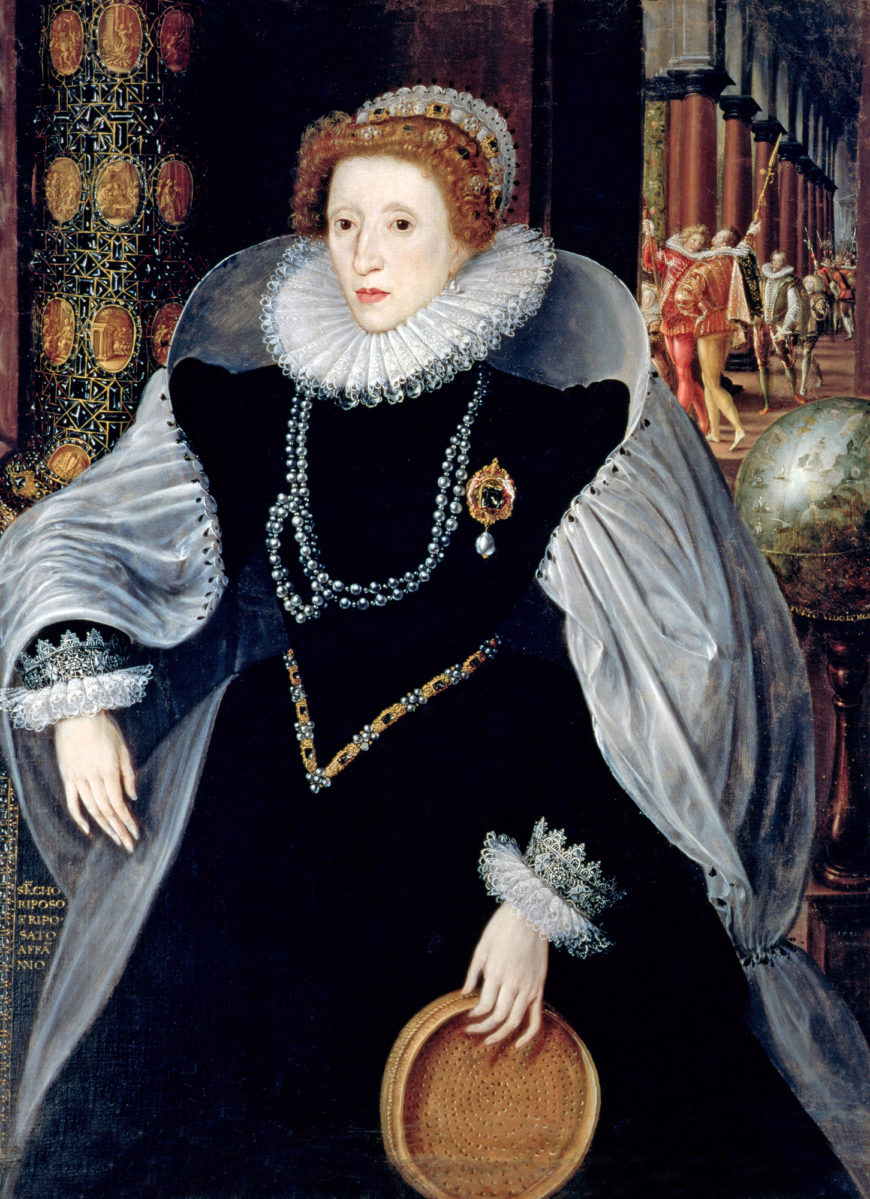
Quentin Metsys II, The Sieve Portrait, c. 1583, oil on canvas, 124.5 x 91.5 cm (Pinacoteca Nazionale, Siena)
The Virgin Queen
Not coincidentally, around this time portraits of Elizabeth make increasingly overt reference to Elizabeth as the “Virgin Queen.” Unmarried women were expected to remain virgins, as Christianity only permitted sex within marriage. Around 1580 several “sieve portraits” were painted, alluding to the ancient Roman Vestal Virgin Tuccia, who proved her chastity by carrying water in a sieve from the Tiber to the temple. In the version painted by Quentin Metsys the Younger, the sieve also becomes an emblem of discernment, labelled with the motto “a terra ilben / al dimora in sella” (the good falls to the ground while the bad remains in the saddle).
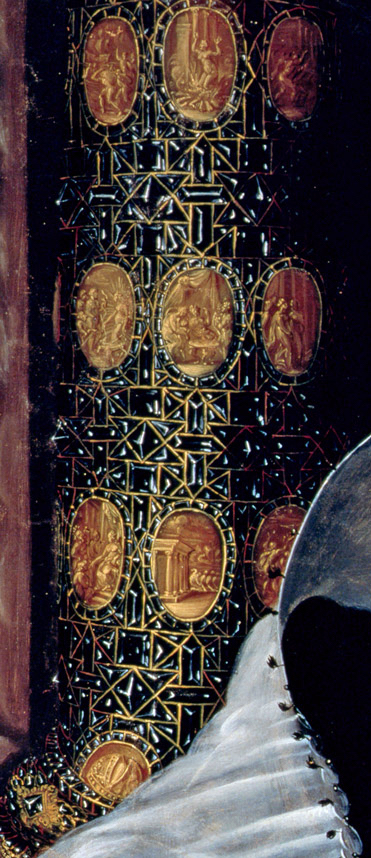
Quentin Metsys II, detail of the column, The Sieve Portrait, c. 1583, oil on canvas, 124.5 x 91.5 cm (Pinacoteca Nazionale, Siena)
Much of the symbolism in this painting is standard in Elizabeth’s portraiture, in particular the column and globe, which refer to England’s imperial ambitions, but the column also reinforces the message of Elizabeth’s virginity and independence: studded with allegorical scenes referencing the classical story of Dido and Aeneas, it pointedly reminds the viewer of the love affair which temporarily distracted Aeneas from his destiny as founder of the Roman Empire. Here again androgyny lurks under the surface, as Elizabeth is identified not with the doomed lover Dido, but the masculine founder of Rome, Aeneas.
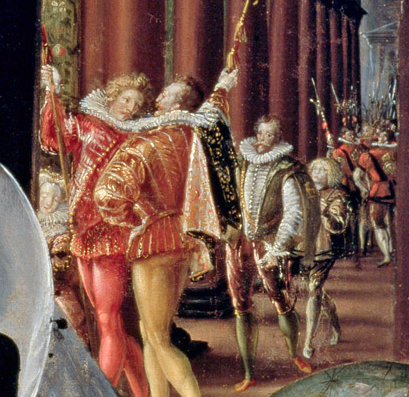
Quentin Metsys II, detail of the possible patron, The Sieve Portrait, c. 1583, oil on canvas, 124.5 x 91.5 cm (Pinacoteca Nazionale, Siena)
In the background we catch sight of the person who probably commissioned this portrait, Sir Christopher Hatton, identifiable by the golden hind on his cloak, a symbol taken from his heraldic crest. Hatton was a major opponent of the Anjou match: whether this portrait was intended to put pressure on Elizabeth by emphasizing her identity as the “Virgin Queen,” or to celebrate Hatton’s successful counsel after the fact, it demonstrates how portraits which on the surface seem to promote Elizabeth’s authority could also put forward an agenda that conflicted with, and even undermined, her own desires.
As Elizabeth’s reign wore on, her status as “Virgin Queen” became an increasingly important symbol of her devotion to her kingdom, and of the security of the realm. We see this in the iconic Armada Portrait which survives in three near-identical versions.

George Gower (attributed), The Armada Portrait, c.1588, oil on oak panel, 110.5 x 125 cm (Woburn Abbey)
The portrait was painted to celebrate the defeat of the invading Spanish navy. Elizabeth rests her hand on the globe, and either side of her head are two windows: through the left the Armada approaches; to the right the fleet is scattered and sinking under stormy skies. In an age when the body of the monarch was inextricably linked with the body politic, the successful defeat of an attempted invasion was personified in the impenetrable body of the Virgin Queen herself. Tightly encased in her bodice, sleeves and ruff, her costume is studded with pearls: sea-grown emblems of virginity and of the Roman goddess Diana. Famously chaste, Diana was also goddess of the moon, so controller of the tides—an appropriate attribute for a queen who had just seen off an Armada.
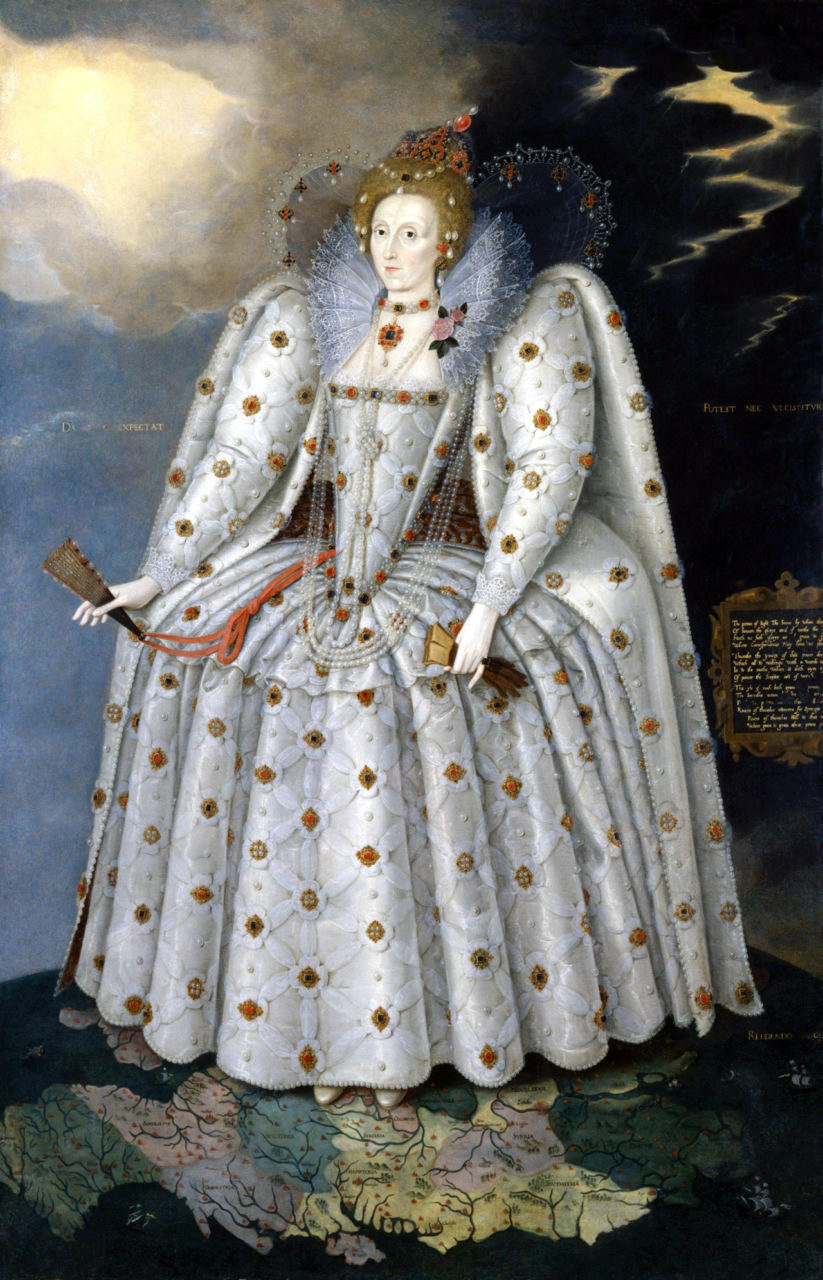
Marcus Gheeraerts the Younger, The Ditchley Portrait, c.1592, oil on canvas, 241.3 x 152.4cm (National Portrait Gallery, London)
Elizabeth the Goddess?
In the final decade of her reign, Elizabeth’s portraiture transforms her into England’s quasi-divine protectress. In the Ditchley Portrait, Elizabeth is represented at roughly life-size, but within the realm of the portrait she is a giantess, standing astride the globe. Her costume, with its huge sleeves and farthingale, all but eliminates the human quality of sex in favor of a more divine representation. Around her the sky changes from pale blue to stormy navy, as if she could control the elements with a flick of her fan. The (partly destroyed) inscription in the cartouche underlines these cosmic themes, referring to Elizabeth as “The prince of light, The Sun.” [7]
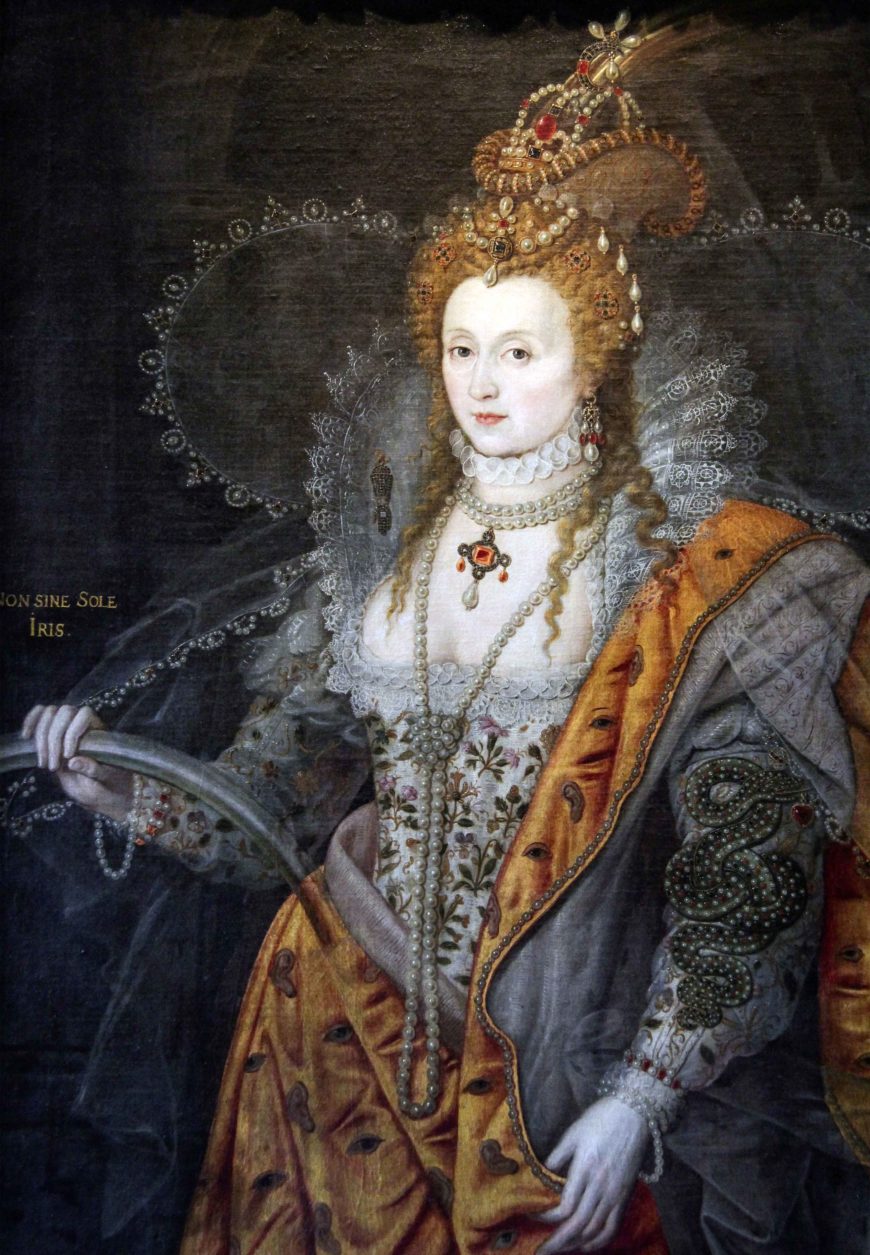
The Rainbow Portrait, c.1600, oil on panel, 127 × 99.1 cm (Hatfield House, UK; photo: Kotomi_, CC BY-NC 2.0)
The Ditchley Portrait is unusual in that it shows Elizabeth as naturalistically aged. Most late images of Elizabeth, such as the Rainbow Portrait, show the queen as improbably youthful, a deliberate tactic designed to allay fears about the succession. Painted at the very end of her reign, the Rainbow Portrait seems to look back to the earliest images of Elizabeth as a princess: her body is feminized and the cut of her bodice is lower.
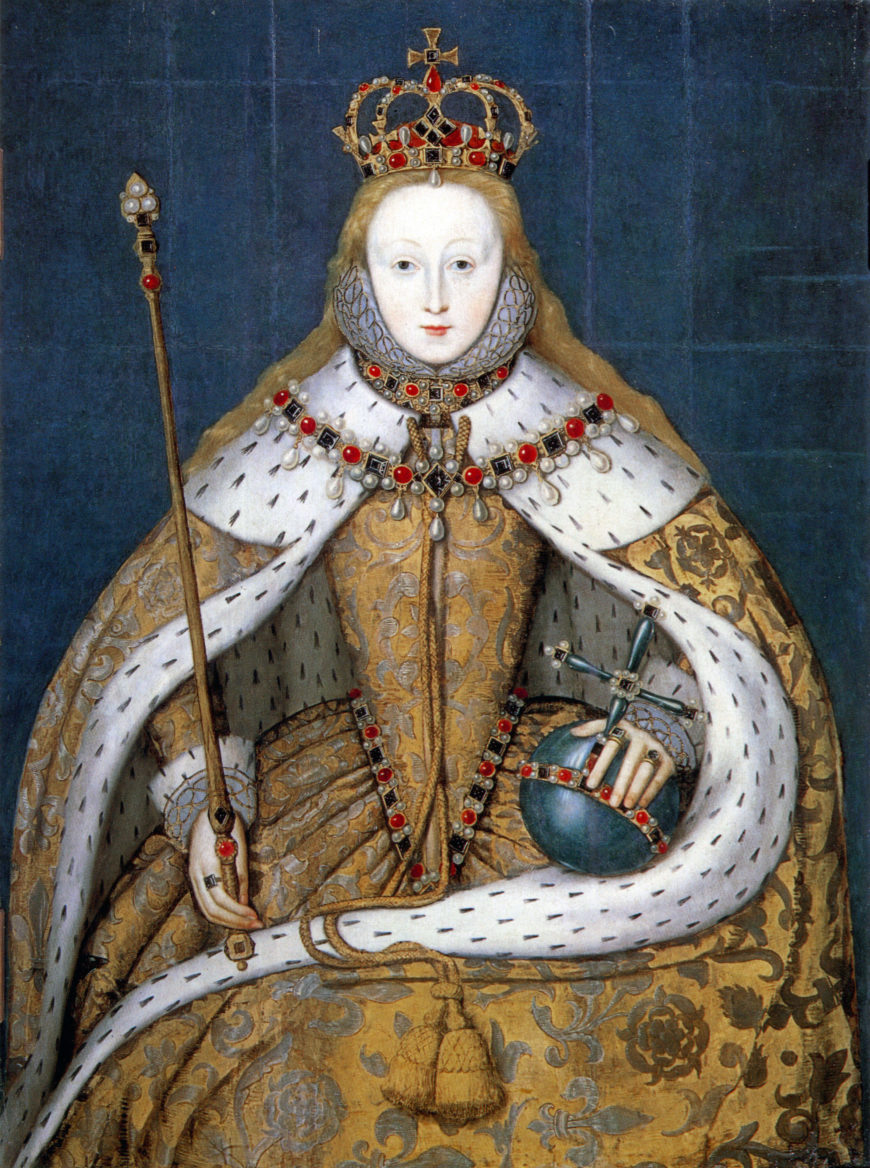
The Coronation Portrait, c.1600, oil on panel, 127.3 x 99.7cm (National Portrait Gallery, London)
Her hair flows down behind her head and strands fall across her elaborate ruff, evoking the Coronation Portrait, which was copied around this time from a lost original. Here at last, artists seem to have found a way of reconciling Elizabeth the woman with Elizabeth the divinely-ordained ruler. She retains emblems of divinity: eyes and ears speckle her cloak, symbolizing omniscience (and the networks of spies controlled by the Cecil family, probable patrons of this portrait) and in her hand she holds a rainbow, alluding to God’s promise to his people after the Flood, here evoking Elizabeth’s commitment to her kingdom. Now, at the end of a more than forty-year rule, artists and courtiers had finally solved the problem of how to represent Elizabeth. For artists, her successor James I would be altogether more straightforward, but far less iconic.



